Hunting Tips, Questions, Stories & Discussion
Focusing on managing Texas wildlife habitat and natural resources for native and exotic wild game species, for this and future generation of hunters and outdoor enthusiasts.Wednesday, December 31, 2008
What type of hunting can I expect at Escondido Ranch?
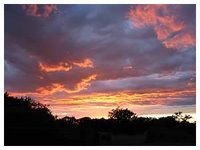 While many Texas hunting ranch properties have hunters traveling for hours just to get to location for the hunt, Escondido offers everything all within a convenient two mile radius. Hunts are done from blinds, meaning that you won't have to worry about trekking for hours only to find nothing you want to shoot.
While many Texas hunting ranch properties have hunters traveling for hours just to get to location for the hunt, Escondido offers everything all within a convenient two mile radius. Hunts are done from blinds, meaning that you won't have to worry about trekking for hours only to find nothing you want to shoot.The blinds are placed along game trails or close to feeders, virtually ensuring you will have a shot at just what you are looking for. Professional guides will help in locating game as well as preparing game for travel. Bring an ice chest, with a success rate of over 90% at this Texas hunting ranch you will need one to bring home the trophy results of your hunt.
For early spring, late fall and winter hunts you will need to dress in layers as the temperature is often around freezing in the morning hours but then climbs into the 60's or even 70's in the afternoon. Late spring, early fall and summer hunts will have warm weather, even night temperatures will be in the 70's and 80's or even higher on most days.
Labels: exotic game hunts, south texas hunting ranch, texas hillcountry deer hunting
What is the lodge like at Escondido Ranch?
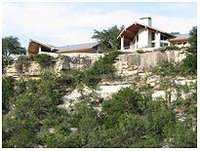 If you are thinking old outdated cabins, having to cut wood and living "close to nature" then you definitely aren't thinking about this Texas hunting ranch. Escondido Ranch offers guests all the comforts of home. The main feature is a common area that is beautifully decorated with both true Texas furnishings as well as some amazing trophy heads in a variety of types of mounts. Not only does this give hunters a visual taste of what they can expect to see on their hunt on the ranch but it also provides an idea of the different ways that the trophies can be displayed.
If you are thinking old outdated cabins, having to cut wood and living "close to nature" then you definitely aren't thinking about this Texas hunting ranch. Escondido Ranch offers guests all the comforts of home. The main feature is a common area that is beautifully decorated with both true Texas furnishings as well as some amazing trophy heads in a variety of types of mounts. Not only does this give hunters a visual taste of what they can expect to see on their hunt on the ranch but it also provides an idea of the different ways that the trophies can be displayed.The décor is very modern with individual rooms and ample place to relax, talk and just enjoy yourself. It is definitely not your average accommodation plus there is the option to arrange for meals prepared for you at the lodge. Since there is limited accommodation at the ranch it is important to book rooms in advance or plan to stay at one of the smaller hotels located just a short distance from Escondido.
What major city is close to Segovia?
One of the wonderful aspects of this Texas hunting ranch is that it is close to a major international airport as well as sightseeing locations for non-hunters and hunters alike. San Antonio, home to the Alamo, Riverwalk, SeaWorld and Six Flags Fiesta is only about 100 miles or just a little over an hour and half drive from Escondido Ranch. In addition the center of the Hill Country, Kerrville, Texas, is only 44 miles down Highway 10. There is ample shopping and entertainment venues in this smaller yet very historic town. The close location of this Texas hunting ranch to a variety of attractions makes it easy to combine a family holiday with a hunting trip since it is easy to keep everyone in the family happy!
The closest major international airport is located in San Antonio for those people that are traveling in from farther away. It is hard to imagine a more convenient location for a Texas hunting ranch and once you make the trip once you will definitely be back for more.
Labels: deer hunting, escondido hunting ranch, exotic game hunts, texas hunting ranches
What is the average lifespan of the Aoudad Sheep?
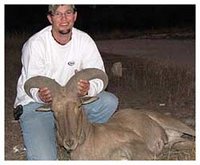 In the wild under good conditions the Aoudad sheep can live to be up to 20 years, longer in captivity. They are very hardy and are not susceptible to the drought and low forage problems that can affect the native species. They can actually go without water for long periods of time and their bodies are able to extract enough water to survive from meager amounts of vegetation.
In the wild under good conditions the Aoudad sheep can live to be up to 20 years, longer in captivity. They are very hardy and are not susceptible to the drought and low forage problems that can affect the native species. They can actually go without water for long periods of time and their bodies are able to extract enough water to survive from meager amounts of vegetation.The main breeding season runs from the first part of September through to the end of November with offspring born from March through to May. Like many species, the Aoudad can breed throughout the year and females will come into season between 18 months and 2 years of age.
Newborn sheep are extremely athletic and can climb around on very rocky and rough terrain
within just a few minutes after birth. The females are very protective of their young and keep them close by until about 4 months of age when they are weaned.
Labels: aoudad hunting, barbary sheep hunting, texas hunting ranch, trophy aoudad sheep
Monday, December 29, 2008
What makes hunting an Aoudad Sheep so challenging?
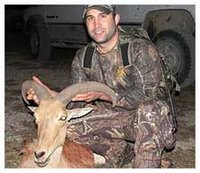 If you are used to hunting from a blind or from a stand, hunting Aoudad sheep can be a whole different ball game. These sheep are much more leery of humans, simply by nature, than are typical native North American deer species. One of the major differences is that the Aoudad relies much more on visual acuity, but also has an amazing sense of smell. Combining these two features really makes this species a true hunting challenge.
If you are used to hunting from a blind or from a stand, hunting Aoudad sheep can be a whole different ball game. These sheep are much more leery of humans, simply by nature, than are typical native North American deer species. One of the major differences is that the Aoudad relies much more on visual acuity, but also has an amazing sense of smell. Combining these two features really makes this species a true hunting challenge.One other peculiarity of the Barbary sheep is that they will always run when they sense danger approaching, however if the danger seems very close they immediately freeze. This freezing can make them very hard to distinguish, especially on the rocky and rather desolate terrain they prefer.
In their native land of Africa hunting an Aoudad is seen as a true test of manhood and it is not an easy process, even for hunters with years of experience. It is this very trait that first attracted North American sportsman to the species. Because Aoudad Sheep do not shed their horns, they can be and are hunted year round.
How many Aoudad Sheep are in Texas?
Since the mid 1960’s the Aoudad sheep population has expanded within the state and even into surrounding and neighboring states. The original few pairs that were imported by Texans stationed in Africa in World War ll simply couldn’t be fenced in and escaped to live in the wild areas of central and southwestern Texas. The living conditions were comparable temperature wise to their native land, but food was much more plentiful. This combination lead to a rapid expansion of the population both in the wild and now on game ranches. It is estimated that there are approximately 25,000 Aoudad sheep now in the state, with more throughout New Mexico. Since these sheep are largely living in small groups throughout some of the roughest terrain in the state, total populations are only an estimate rather than a hard number.
Labels: aoudad sheep hunting, barbary sheep hunts, exotic game hunt
What is the best time to hunt for Sika deer?
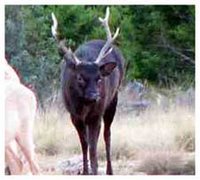 Sikas prefer the dark and dusk hours to do their feeding and moving, so early morning hunts are the best option. Getting to the blind well in advance of the first signs of daylight is a must, however with patience the hunter will be in a great position to see and hopefully bag a gold medal buck. By far the Sika deer are most active in the rut season in the spring and fall. The bucks are much more likely to be out and about in the early and pre-dusk hours, plus they will bugle, alerting hunters to their general position and vicinity.
Sikas prefer the dark and dusk hours to do their feeding and moving, so early morning hunts are the best option. Getting to the blind well in advance of the first signs of daylight is a must, however with patience the hunter will be in a great position to see and hopefully bag a gold medal buck. By far the Sika deer are most active in the rut season in the spring and fall. The bucks are much more likely to be out and about in the early and pre-dusk hours, plus they will bugle, alerting hunters to their general position and vicinity.Labels: exotic deer hunt, sika buck hunting, sika deer hunts
Monday, December 22, 2008
What is the history of the Sika species in other countries?
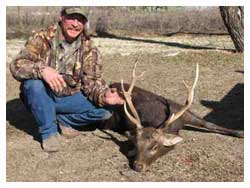 Although considered a highly prized trophy animal in North America and even in Europe, they have also been seen as sacred animals in the Japanese culture. The largest natural population in Japan was in the area of the island of Hokkaidō, where they were even used as domestic animals for meat. Over hunting of the wild herds almost caused extinction in the areas around Hokkaidō, however they were declared a protected species in the early 1900's and the population rapidly increased again until they reached their former levels. Currently regulated hunting is again permitted to help control the population and avoid over-competition for forage with livestock.
Although considered a highly prized trophy animal in North America and even in Europe, they have also been seen as sacred animals in the Japanese culture. The largest natural population in Japan was in the area of the island of Hokkaidō, where they were even used as domestic animals for meat. Over hunting of the wild herds almost caused extinction in the areas around Hokkaidō, however they were declared a protected species in the early 1900's and the population rapidly increased again until they reached their former levels. Currently regulated hunting is again permitted to help control the population and avoid over-competition for forage with livestock.In several areas of Japan including the scared temple cities of Nara and Miyajima the Sika deer roam around the cities with the tourists. They can be fed by hand and are very tame and accepting of human contact. In other countries such as the Britain, France, Australia, New Zealand, Germany and Denmark there are both managed herds and completely wild populations. In European areas the Sika deer will breed with native Red Deer, resulting in a hybrid species that is considered to be a risk to the preservation of the purebred Sika and Red Deer populations. In the United States the species is found in wild and managed herds in Texas and Maryland. They can also be found on private reserves and zoos throughout the rest of the country.
Labels: sika buck hunts, sika bucks, sika deer hunting
Friday, December 19, 2008
Can you determine the age of a Texas whitetail deer by the number of tines on the antlers?
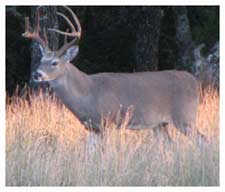 While this is sometimes given as a method of determining the age of a whitetail buck in reality it is simply not accurate or a true method of aging a buck. It is more likely that Texas whitetail deer bucks either have four or five tines on each antler once they reach maturity, not that they continue to get more as they age. Some researchers have indicated that the diameter of the beam or central part of the antler may be used for estimating age with the thicker the beam the older the buck. Other researches are less convinced that this is accurate since antlers are grown each year and poor grazing conditions or exceptionally good years can increase or decrease the diameter of the beam regardless of the age.
While this is sometimes given as a method of determining the age of a whitetail buck in reality it is simply not accurate or a true method of aging a buck. It is more likely that Texas whitetail deer bucks either have four or five tines on each antler once they reach maturity, not that they continue to get more as they age. Some researchers have indicated that the diameter of the beam or central part of the antler may be used for estimating age with the thicker the beam the older the buck. Other researches are less convinced that this is accurate since antlers are grown each year and poor grazing conditions or exceptionally good years can increase or decrease the diameter of the beam regardless of the age.It is possible to tell the age by the teeth. Milk incisors will be shed sometime before 18 months and the teeth will have sharp ridges that have not yet been worn down from use. At approximately 2 years of age the molars are completely in and the full adult set of teeth is visible. By 5 years of age the teeth are starting to significantly wear and the grinding surfaces continue to wear with use.
Labels: texas hunting ranches, texas whitetail deer, trophy antlers, trophy whitetail buck
Thursday, December 11, 2008
Where is the best place to find Texas whitetail deer at different times of the day?
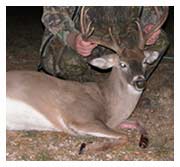 The Texas whitetail deer changes locations according to the time of day. In the early morning and dusk hours you can find them along the edge of brushy areas, even into the middle of pastures, meadows and open spaces. They will be actively grazing on grasses and browse at these times. Typically Texas whitetail deer like to be relatively close to pine, hardwood or brushy areas to be able to quickly take cover. In the afternoon hours and the bright daylight they are found in deeper wooded areas in well sheltered and protected locations. During this time they are resting, ready to feed again at sunset. They will often feed well into nightfall, then again retreat to their bedding areas to rest and digest the food.
The Texas whitetail deer changes locations according to the time of day. In the early morning and dusk hours you can find them along the edge of brushy areas, even into the middle of pastures, meadows and open spaces. They will be actively grazing on grasses and browse at these times. Typically Texas whitetail deer like to be relatively close to pine, hardwood or brushy areas to be able to quickly take cover. In the afternoon hours and the bright daylight they are found in deeper wooded areas in well sheltered and protected locations. During this time they are resting, ready to feed again at sunset. They will often feed well into nightfall, then again retreat to their bedding areas to rest and digest the food.Most Texas whitetail deer don’t travel too far from their home range area unless there is a shortage of food. Since managed locations such as Escondido Ranch carefully control the population of the deer and other species there is little need for the animals to travel during daylight hours.
The females will come into season around the two year mark although with excellent grazing and environmental conditions they may successfully be bred earlier.
Labels: texas deer hunting, texas whitetail deer, whitetail deer hunt, whitetail deer hunts
What is the trick to getting a trophy buck?
This deer is extremely agile and is able to maneuvere through bush and over rough terrain with ease. Even skilled hunters may get off a single shot but it is unlikely they will get off more unless they are very well positioned. Bucks and the herd are very unlikely to return to the same spot where they have been hunted on a repetitive basis so it is important to have a variety of feeding areas that they can rotate through.
Why are some antlers palmate and some spike type antlers?
The Fallow deer buck will produce short beam and spike type antlers until they are fully mature at three to four years of age. They shed these antlers every year while they are allowed to stay with the largely female herd. After four years they begin to produce the palmate type antlers that are most valued for trophy mounts. It is not uncommon for a mature bucks to have an antler width of up to 25cm and a length of approximately 39cm.
Labels: exotic deer hunt, fallow deer hunting, texas deer hunts
Fallow Deer: Is there a standard color for this species?
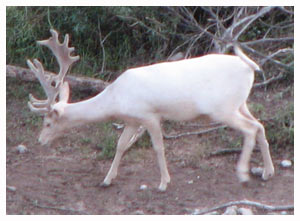 For many hunters a Fallow deer seems like a bit of a strange species. Most hunters are used to hunting deer and being able to tell immediately what it is because there is only one possible coloration and pattern on the coat. The Fallow deer, however, actually has four separate and distinct color variations. Each is unique in its own way, but they are all the same type and species of deer. There are typically only three color variations seen in Texas and they are described below:
For many hunters a Fallow deer seems like a bit of a strange species. Most hunters are used to hunting deer and being able to tell immediately what it is because there is only one possible coloration and pattern on the coat. The Fallow deer, however, actually has four separate and distinct color variations. Each is unique in its own way, but they are all the same type and species of deer. There are typically only three color variations seen in Texas and they are described below:Melanistic – this is the darkest of the colors. It is an almost pure black coat coloration, sometimes black to very, very deep brown, with a white rump patch. Often this very dark coated Fallow deer is mistaken for a Sika deer at first glance.
White – likely the most commonly seen color variation, white coated Fallow deer are not albinos, they are a true white. The coat can range from a creamy color through to a champagne and white color. Unlike a true albino the eyes and skin are the normal color, not pink like you may expect.
Menil – this color variation includes a darker fawn color with white spots in the summer and a brownish gray coloration during the winter months. The heavier winter coat may retain some of the brown color or may be almost completely gray.
The fourth color variation is lighter than the menil with the spots almost never present during the winter months.
Labels: deer hunting, exotic deer, fallow deer, texas hunting ranch
Are Black Buck Antelope always the same color?
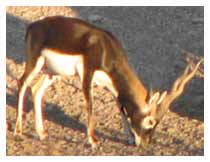 Throughout the breeding seasons the Black buck antelope males always have the black to very dark brown dorsal markings that lighten slightly towards the belly. The under belly, inner legs, eye rings, chin patch and chest are white, with the outer coat darker brown to rusty red. After the spring breeding season the males will molt, producing a lighter colored coat all over the body. Typically the dark dorsal area stays about the same color but the lighter colorations do fade slightly to very dark tan to rusty-red colors.
Throughout the breeding seasons the Black buck antelope males always have the black to very dark brown dorsal markings that lighten slightly towards the belly. The under belly, inner legs, eye rings, chin patch and chest are white, with the outer coat darker brown to rusty red. After the spring breeding season the males will molt, producing a lighter colored coat all over the body. Typically the dark dorsal area stays about the same color but the lighter colorations do fade slightly to very dark tan to rusty-red colors.Young Black buck antelope males that are not fully mature and females are more of a dark tan color without the heavy dark along the back. Bucks are very prized for this distinctive coat as well as the beautiful markings on the face and neck, terrific for a full body mount.
Labels: antelope hunts, black buck hunting, exotic game hunt
Sunday, December 7, 2008
What makes Texas a good location for Black Buck Antelope?
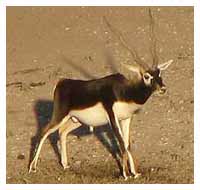 Texas is very similar in many ways to the native range areas of the Black buck Antelope in India and Pakistan. While these locations are not close geographically to each other they still have the same warm summer climates, moderate winter climates and the dryer, lower level rainfalls. In addition the types of grasses and forage is remarkably similar, making an easy transition for the species.
Texas is very similar in many ways to the native range areas of the Black buck Antelope in India and Pakistan. While these locations are not close geographically to each other they still have the same warm summer climates, moderate winter climates and the dryer, lower level rainfalls. In addition the types of grasses and forage is remarkably similar, making an easy transition for the species.It is interesting to note that in India hunting of the wild native Black bucks is now completely prohibited because of the low numbers. Increasing expansion of agricultural and urban areas is destroying much of their range and only isolated pockets of wild herds still exist in the country. Managed Texas areas such as the Escondido Ranch carefully control the numbers hunted per year, ensuring a good population and protection for the species in the state.
How fertile is the species and how hard is it to keep a good sized herd?
The Black buck antelope is a species that breeds year round, although most of the young are born in the spring through fall seasons. With the warmer, milder climates in central Texas even winter born fawns are very healthy and typically survive without any human intervention. Females begin to breed at approximately a year and a half of age, depending on grazing conditions and overall health issues. In managed herds it is possible for females to actually come into season at just over one year.
Black buck antelope fawns are almost always born as single offspring, with a five month gestation period. Since females will breed again typically one to two months after they have the first fawn it is possible for each mature female to produce two offspring per year. Herd managers have to constantly monitor the number of bucks and does within the herd as well as the number of offspring produced. Through good record keeping and monitoring the numbers hunted off any game ranch a standard sized herd the has the best trophy type animals can be maintained year round and from season to season.
Labels: antelope hunting, black buck antelope, texas hunting ranch
Archives
December 2008 January 2009 February 2009 April 2009 May 2009 June 2009 July 2009 August 2009 September 2009 November 2009 December 2009 January 2010 February 2010 March 2010 April 2010
Subscribe to Posts [Atom]
